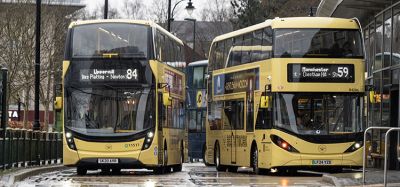A modern system for Modena
- Like
- Digg
- Del
- Tumblr
- VKontakte
- Buffer
- Love This
- Odnoklassniki
- Meneame
- Blogger
- Amazon
- Yahoo Mail
- Gmail
- AOL
- Newsvine
- HackerNews
- Evernote
- MySpace
- Mail.ru
- Viadeo
- Line
- Comments
- Yummly
- SMS
- Viber
- Telegram
- Subscribe
- Skype
- Facebook Messenger
- Kakao
- LiveJournal
- Yammer
- Edgar
- Fintel
- Mix
- Instapaper
- Copy Link
Posted: 31 March 2006 | ET | No comments yet
Having already successfully adopted one of the first magnetic-based automatic fare collection systems in Italy, operator ATCM is not content to rest on its laurels. The company is about to start using an advanced fare collection and revenue management system using the latest smart card technology. Christian Shelton reports.
In 1994 ATCM was one of the first operators in Italy to introduce a magnetic-based automatic fare collection system. The system was first used on ATCM’s Modena bus and rail services.
Having already successfully adopted one of the first magnetic-based automatic fare collection systems in Italy, operator ATCM is not content to rest on its laurels. The company is about to start using an advanced fare collection and revenue management system using the latest smart card technology. Christian Shelton reports. In 1994 ATCM was one of the first operators in Italy to introduce a magnetic-based automatic fare collection system. The system was first used on ATCM’s Modena bus and rail services.
Having already successfully adopted one of the first magnetic-based automatic fare collection systems in Italy, operator ATCM is not content to rest on its laurels. The company is about to start using an advanced fare collection and revenue management system using the latest smart card technology. Christian Shelton reports.
In 1994 ATCM was one of the first operators in Italy to introduce a magnetic-based automatic fare collection system. The system was first used on ATCM’s Modena bus and rail services.
According to Gabriele Minghetti, IT and Administrative Manager at ATCM, the magnetic system brought a number of advantages, for both the operator and the passengers: “It allowed us to move away from issuing travel cards with a time-based validity system to issuing cards with a value-based validity and it also enabled ATCM to charge fares based on zones instead of travel distance. A passenger would pay a set fare for travelling within a zone. To cross from one zone to another the fare would increase by a set amount”.
In other words, ATCM phased out weekly, monthly and annual cards and introduced cards that held a monetary value.
The advantage of this from the passengers’ perspective was that they only had to pay for the services that they actually used. If a passenger was ill, or there was a public holiday and they did not travel, at least they were not paying for a service they were not using.
Passengers also benefited from the discount offers that the value-based system was able to offer. Minghetti explained: “We introduced an automatic stepped discount system based on passenger use within a 12 month period. The discounts offered started at a 20% discount from the base fare and went up to as much as an 80% discount for heavy-users.”
ATCM was also able to introduce other discount policies – such as rewarding passengers who travelled in off-peak times. The only time-based cards that ATCM retained were for the elderly, for disabled people and for school children.
One of the main challenges in introducing this new system for ATCM was that by switching to magnetic-value based cards, passengers needed somewhere they could add value to their cards in an easy manner, on a regular basis.
Previously, the paper made season cards were sold through a network of kiosks and tobacconists. However, supplying these ticket outlets with the machinery to add value to the cards would have been an expensive task.
It would also have meant that passengers could not add-value to cards once the kiosks and shops had closed for the night. So ATCM approached three local banks and reached an agreement where the bank’s ATM (cash-point) machines would be adapted to be able to add value to the cards. Thus passengers were able to add-value at any time day or night. It also benefited the banks which were keen to encourage the general population to start using ‘electronic’ money.
There is now a network of 150 ATMs across the region and just 13 sales points. Also, ATCM does not need to pay as much of a percentage of ‘ticket sales’ to the banks as it did to the retail outlets that sold tickets on its behalf – with savings on these commissions of up to 50%.
The system has proven to be very popular. In 2005, out of the 79,000 cards that were used on ATCM’s routes – approximately 67,000 of these were value-based cards. So ATCM has been successful in encouraging as many of its passengers as possible to move away from using disposable, single paper tickets to using the re-usable magnetic cards. According to Minghetti: ”We have moved from a situation where approximately 60% of passengers used single tickets and 45% used season tickets to one where 30% of passengers now use single tickets and 70% use the value-based magnetic cards.”
Minghetti explained that one of the main reasons why ATCM wanted people to switch to using the magnetic value-based cards was so that they could gain a better understanding of how its services were being used: “Data about service use could be collected when passengers validated their cards on a bus. It has allowed us to reshape our services across the region – providing a more effective transport service and also reducing the number of complaints where services had to be cut.”
The other advantage for ATCM was that the value-based system laid the way for future development. ATCM wanted a system that could potentially be expanded across the whole of the Emilia Romagna region. This would mean that it would be used by other operators. And if this was the case, they needed a system that could have a fair split of income between the different operators. To do this effectively, the system had to be a value-based system.
Problems of the magnetic card system
Although the value-based magnetic card system proved popular, it was not without its problems. The main passenger complaint was that occasionally the card did not work properly. It would become unreadable and the only way for the passenger to retrieve the value that was on it was to take it to one of ATCM’s own sales points – where the information on the value on the card could be recovered.
The other problem, for ATCM, was that the magnetic card validators had been in service for 12 years. In order to maintain them in top working order, ATCM was spending in the region of ?300,000 per year. The main reason for this was because the system used moving parts, which were prone to wear and tear. This was compounded by the fact that the machines accepted both paper and plastic tickets. The paper tickets created ‘paper dust’ in the validator and they also needed to be marked – to show that they had been validated. This meant that ATCM had to install a printer in the machines – even though they were not designed for this – and it resulted in the validators being less user-friendly.
The contact-less smart card system
ATCM saw that automatic fare collection technology had advanced and that contact-less smart cards would offer a potential solution to these problems. So since June 2005 ATCM has been trialling the latest smart card technology supplied by Cubic Transportation Systems.
The trial involved 60 drivers, 16 buses and 1000 smart cards which were distributed to the general public. Out of this 1000, 500 were actually used over a set two week period. The passengers using the trial cards were asked to fill out a questionnaire about how the card performed.
Minghetti outlined the results: “The average mark out of 10 given for the new system was 8.7 – which was good. We also asked the test subjects what they though of the old magnetic system after having used the new one – and the average for the magnetic system was 7 out of 10.
“97% of the respondents preferred the new system. Out of this 97%, 34% found the new system easier to use, 27% found it quicker and 32% said they preferred it as there was less possibility of losing the value from the card.
“Most of the respondents said that it was very easy to understand how to use the card, although we asked if they had difficulties the first time they used it. 14% of respondents did have difficulties understanding how to use it at first. So we asked ‘what kind of difficulties’? Out of this small 14% that had difficulties – 80% did not see where the validator was because it was a bit smaller. 20% did not know if the validation had occurred or not because unlike the old system, the card was not returned signifying that the validation was complete. However, the new validators do make a noise and a sign and text flashes up.
“We then asked ‘after a few days did you still have difficulties?’ The figure then decreased from 14% to 8%. Out of the 8% – the main problem was still to understand when the validation was over. So we concluded that although the new system is preferred we still have to work on making people understand how to use it properly.”
According to Minghetti the new smart card system will provide a number of benefits for ATCM: “We do not expect the smart card to deteriorate in the same way that the magnetic ones did. Also, we expect the embarking times on the buses to be reduced – as validating the contact-less card is easier and quicker. We also expect our maintenance costs to decrease – as there are no mechanical moving parts on the validator.”
Integration between the automatic fare collection and automatic vehicle monitoring systems
Another very important aspect of the new system is the upgrade of the communications system, provided by Italian company t&t (Telematica e Trasporti), that allows ATCM to collect data in a much shorter time than the old system allowed.
“Previously we had to wait until the buses went to the depot for refuelling before we could retrieve the data from the magnetic validators. Now this data can be retrieved at any point – even when the bus is on the road. This gives us greater freedom in finding out exactly what is happening on the services it provides,” said Minghetti.
The new ‘Driver Control Unit’ not only deals with the automatic fare collection system but also becomes the only interface for drivers with other systems such as automatic vehicle monitoring.
The system updates the bus control room with the exact location of the bus automatically. This also allows the fares between the different zones to be calculated automatically – as the bus ‘knows’ exactly where it is at any time.
The GPS system is also used to provide real time passenger information (RTPI) – both at bus stops and for the on-board displays.
The system also allows the driver to communicate with the control room. There are 10 pre-set SMS messages he can send just by pushing a button. The driver can also send surreptitious ‘emergency’ messages to the control room without being detected by the passengers – so the system also provides an added security function.
The ticketing and position monitoring functions are all carried out by a set of computers designed from the start as an ‘all-in-one’ system which, according to Minghetti, is quite unusual and innovative.
Switching to the new system
ATCM will continue to maintain a reduced number of magnetic validators on its services. They currently have 800 validators located in a number of locations of the buses. There will now be just one magnetic validator – located next to the new contact-less validators. So they will have the two systems running side-by-side.
Before ATCM launches the new smart cards it needs to finalise new ways in which customers can add value to the cards – as the current ATM system does not work with the new smart cards. However, Minghetti is confident that they will be able to resolve this challenge. Minghetti says that there are two potential ways to do this: “First, we are looking at still using the ATM machines as a kind of wireless internet connection, which sends information to the bus – so that when the customer next validates the card the money the customer has transferred is added automatically. Another method would be for users to give ATCM their credit card numbers and ask for a predefined amount to be added to the card when it goes below a certain amount.”
Whatever happens, Minghetti is insistent that the system will not be launched without an easy way for customers to add value to the contact-less smart cards. Minghetti said: “I do not want to launch the system with the objection –‘there is no easy way to add money to our new cards’ – as this would overshadow all the positive aspects of the new cards.”
Minghetti hopes that the new system will be ready for launch at the end of the summer. It will be launched with marketing campaign – however, judging by ATCM’s past success and by the response of the general public to the trials, the system looks set to be a hit.
Related topics
Ticketing & Payments
Issue
Issue 1 2006








